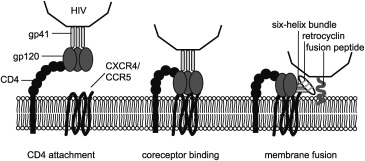Figure 6.

Simplified mechanism of HIV virus entry into a host cell. The HIV virus attaches to the host cell membrane by binding of the viral gp120 protein with a CD4 receptor on the host cell surface. Changes in the conformation of gp120 then allow it to bind to the coreceptor, either chemokine receptor CXCR4 or CCR5. Coreceptor binding exposes the hydrophobic gp41 fusion peptide, which inserts into the host cell membrane. Each subunit of the trimeric gp41 protein then folds in half to form the six‐helix bundle, drawing the viral and host cell membranes together and resulting in membrane fusion. Retrocyclin is thought to inhibit HIV entry by binding to the six‐helix bundle of gp41.
